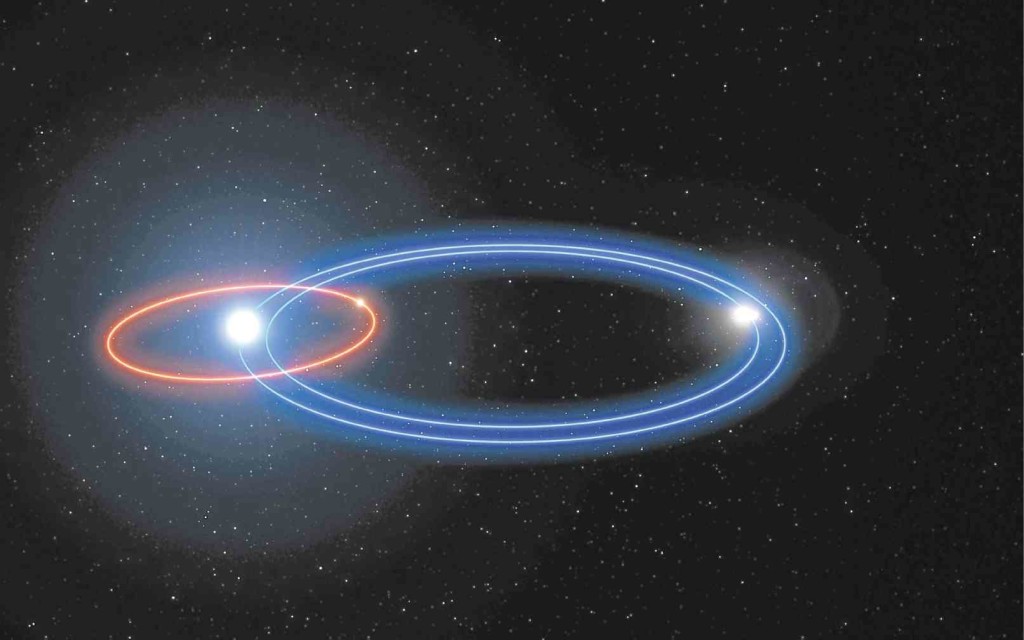
STRANGE NEW PLANET An image provided by the European Southern Observatory shows an illustration of the orbit of the newly discovered gassy planet that belongs to the constellation Centaurus some 320 light-years away. Astronomers say the giant planet has three suns. ESO via AP
CAPE CANAVERAL, FLORIDA—Imagine a planet with triple sunrises and sunsets every day for part of the year, and nonstop daylight at other times.
Astronomers revealed such a place on Thursday: a strange new world in the constellation Centaurus that has not one, not two, but three suns.
What’s more, a year there lasts half a millennium from Earth’s perspective.
This distant world appears even more unusual than the home planet of Luke Skywalker in the Star Wars saga, Tatooine, which orbited around two suns, according to the findings published in the US journal Science.
Such binary solar systems may be relatively common in the universe, but experts say those involving three stars or more are rare.
“Imagine this: a planet where you would either experience constant daylight or enjoy triple sunrises and sunsets each day, depending on the seasons, which happen to last longer than human lifetimes,” said a statement from the University of Arizona, which led the astronomy team.
Nature’s surprises
Discoverer and lead author Kevin Wagner said he was thrilled “to have seen such a beautiful part of nature that nobody else has seen.”
As amazing as three sunsets and sunrises are, “I think nature will have some other surprises in store for us as we continue exploring,” Wagner, a doctoral student at the University of Arizona at Tucson, said via e-mail.
‘550 Earth years to orbit’
Triple-star systems with detected planets are rare enough; this is believed to be just the fifth such discovery.
But the giant gassy world in this one—formally known as Planet HD 131399Ab—has the biggest known orbit in a multi-star system.
Its orbit is double Pluto’s—or roughly 550 Earth years. That’s how long it takes to orbit its system’s brightest star, a super-size sun. The two smaller stars orbit one another and, as a pair, orbit with their big stellar brother.
Planet HD 131399Ab has four times the mass of our own Jupiter. With such a wide orbit and companion stars, scientists would expect a planet like this to be kicked out in a tug of stellar war. Yet that’s not the case.
During part of the planet’s orbit, all three stars are visible on the same day, offering triple sunrises and sunsets and allowing for day and night.
Continuous daylight
For about one-fourth of its year—around 100 to 140 Earth years—there’s continuous daylight. That’s because as the big sun is rising, the two smaller ones are setting.
“With three suns, the planet will see different weird combinations of sunrises and sunsets,” said coauthor Daniel Apai, a University of Arizona astronomer.
“This is a system for which I would not want to design a calendar,” he said.
The astronomers used the European Southern Observatory’s Very Large Telescope in Chile to spot the planet 320 light-years away. It is one of the few exoplanets—planets outside our own solar system—to be directly imaged.
Most exoplanets are identified by periodic dips in starlight as the planets pass between us and their stars.
Naming the planet
As for the planet’s alphabet-soup label, “I wish we had a better name,” Wagner noted.
There is an official protocol for naming planets and their surface features. The International Astronomical Union, in fact, has a relatively new group to handle public naming campaigns.
“Informally, we called it “The Planet,” Apai said in an e-mail.
“But with more possible planet candidates in sight, we will have to change this soon.” Reports from AP and AFP/TVJ
RELATED STORIES
Teenager discovers new planet 1,000 light years away
1st PH-made satellite set to go into space